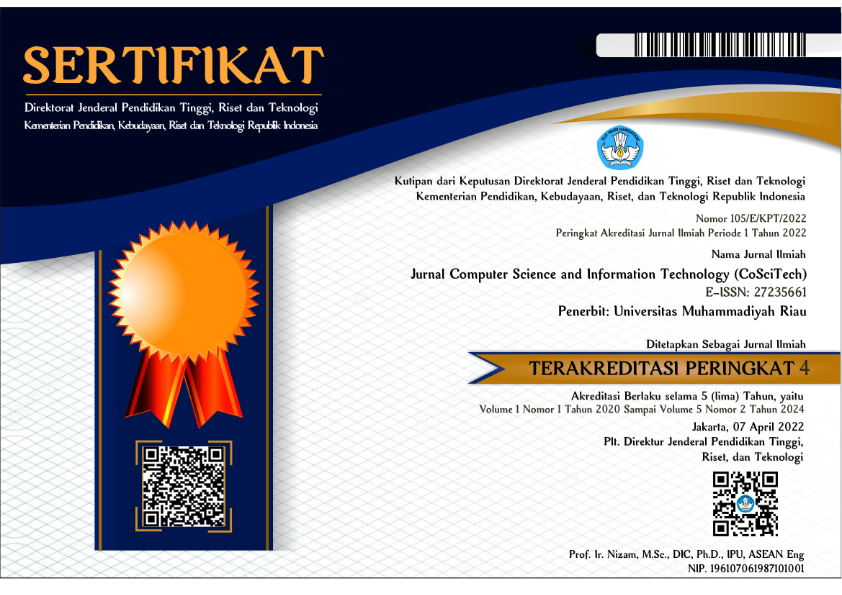Testing the wireless router security system in a smart home ecosystem based on NIST sp800-115
DOI:
 https://doi.org/10.37859/coscitech.v4i3.6315
https://doi.org/10.37859/coscitech.v4i3.6315
Abstract
It is important to safeguard personal information captured by the device being used against theft or unauthorized use, which makes network design that is more resistant from hacking attempts. This includes personal information within the ecosystem of smart homes. A house that should be the most comfortable place should not be disturbed because of the wrong configuration of the smart home ecosystem. Several previous studies have discussed security configuration gaps in network infrastructure, but have not focused on the smart home ecosystem from the user's internal side. Therefore, in this research, a 2.4 GHz wireless network configuration testing model is proposed in a smart home ecosystem using an application developed specifically for checking misconfiguration security gaps, which is expected which is expected to expand research on network infrastructure security gaps based on the NIST 800-115 framework. The application's testing technique can reveal details about a wireless network ecosystem's safe and risky conditions. The results of these findings will provide recommendations to wireless network owners to take action to reconfigure their wireless networks to make them more secure.
Downloads
References
“Badan Pusat Statistik.” Accessed: Dec. 19, 2022. [Online]. Available: https://www.bps.go.id/publication/2022/09/07/bcc820e694c537ed3ec131b9/statistik-telekomunikasi-indonesia-2021.html
D. Cearley et al., “Top 10 strategic technology trends for 2020: A Gartner trend insight report.”
K. Patel, S. Patel, P. Scholar, and C. Salazar, Internet of Things-IOT: Definition, Characteristics, Architecture, Enabling Technologies, Application & Future Challenges. 2016.
S. Garfinkel, G. Spafford, and A. Schwartz, Practical Unix & Internet Security, 3rd Edition, 3rd edition. Beijing ; Sebastopol, CA: O’Reilly Media, 2003.
O. Anthony, “INTRUSION DETECTION IN INTERNET OF THINGS (IOT),” International Journal of Advanced Research in Computer Science, vol. 9, pp. 504–509, Feb. 2018, doi: 10.26483/ijarcs.v9i1.5429.
E. Handoyo, “Analisis Tingkat Keamanan Informasi: Studi Komparasi Framework Cobit 5 Subdomain Manage Security Services (DSS05) dan NIST Sp 800 – 55,” Jurnal CoSciTech (Computer Science and Information Technology), vol. 1, no. 2, Art. no. 2, Oct. 2020, doi: 10.37859/coscitech.v1i2.2199.
M. S. Mulya, I. Yustiana, and I. L. Khrisma, “Rancang Bangun Sistem Keamanan dan Monitoring Kendaraan Berbasis IoT dan Mobile Apps,” Jurnal CoSciTech (Computer Science and Information Technology), vol. 3, no. 2, Art. no. 2, Aug. 2022, doi: 10.37859/coscitech.v3i2.3934.
R. Sahtyawan, “PENERAPAN ZERO ENTRY HACKING DIDALAM SECURITY MISCONFIGURATION PADA VAPT (VULNERABILITY ASSESSMENT AND PENETRATION TESTING),” Journal of Information System Management (JOISM), vol. 1, no. 1, Art. no. 1, Jul. 2019, doi: 10.24076/joism.2019v1i1.18.
K. Scarfone, M. Souppaya, A. Cody, and A. Orebaugh, “Technical Guide to Information Security Testing and Assessment,” National Institute of Standards and Technology, NIST Special Publication (SP) 800-115, Sep. 2008. doi: 10.6028/NIST.SP.800-115.
E. Fernandes, J. Jung, and A. Prakash, “Security Analysis of Emerging Smart Home Applications,” in 2016 IEEE Symposium on Security and Privacy (SP), May 2016, pp. 636–654. doi: 10.1109/SP.2016.44.
W. M. Kang, S. Y. Moon, and J. H. Park, “An enhanced security framework for home appliances in smart home,” Human-centric Computing and Information Sciences, vol. 7, no. 1, p. 6, Mar. 2017, doi: 10.1186/s13673-017-0087-4.
M. Purweni, D. Hariyadi, F. E. Nastiti, and F. Fazlurrahman, “Model Inspeksi Keamanan Jaringan Nirkabel Dengan Teknik Wardrving Berbasis ChatBot,” 1, vol. 6, no. 2, Art. no. 2, Nov. 2022, doi: 10.31603/komtika.v6i2.7943.
P. Herzog, “Open-Source Security Testing Methodology Manual.” Accessed: Dec. 24, 2022. [Online]. Available: https://untrustednetwork.net/files/osstmm.en.2.1.pdf
Z. Akram, M. A. Saeed, and M. Daud, “Wardriving and its Application in Combating Terrorism,” in 2018 1st International Conference on Computer Applications & Information Security (ICCAIS), Apr. 2018, pp. 1–5. doi: 10.1109/CAIS.2018.8442035.
H. S. Shreenidhi, S. Prabakar, and P. A. Kumar, “Intrution detection system Using IoT device for safety and security,” in 2021 International Conference on Computational Intelligence and Knowledge Economy (ICCIKE), Mar. 2021, pp. 340–344. doi: 10.1109/ICCIKE51210.2021.9410730.
T. Mahmud and M. Monirujjaman Khan, “A Medical App based Automated Disease Predicting Doctor,” in 2021 5th International Conference on Computing Methodologies and Communication (ICCMC), Apr. 2021, pp. 478–485. doi: 10.1109/ICCMC51019.2021.9418435.














